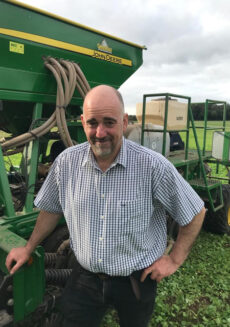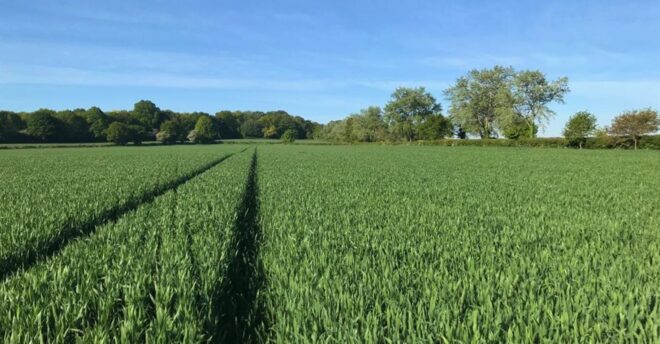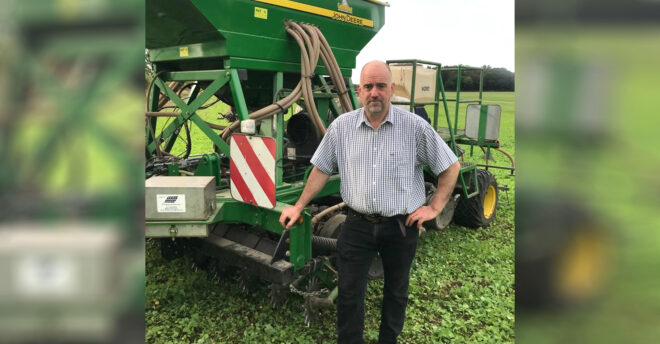Farm manager Tim Parton has utilised biologicals (bacteria) and grass to enhance soil health and create a carbon sink at Brewood Park Farm, Wolverhampton. Having always harboured a deep interest in soil, Mr Parton started to expand on his passion as early as the 1990s, but it was in 2009 – when he realised the farm needed to support itself without subsidies – that he really began to make changes.

Farmer Tim Parton with his John Deere 750A no till drill.
“I class myself as a biological farmer,” he explains. “We haven’t used insecticides for six or seven years, hardly use fungicides or seed dressings and have cut fertiliser use. It’s about getting the correct nutrition for the plants, getting the soil to function and the potassium to cycle.”
Better soil for more carbon sequestration
Having realised farming needed to improve soils to capture more carbon, Mr Parton first started trying to fix nitrogen in 2012 and began to play with strip tilling in 2015 before going to zero till. “As farmers, we cannot continue to use the excuse that there are 8bn people to feed – we can farm just as efficiently while regenerating the planet along the way. Demanding more nutritionally dense food is something everyone is responsible for – there is no planet B.”
When he started altering his farming method and looking into adopting biologicals he had to go and find the information for himself. “There was no one to ask – especially with biological farming.”
We haven’t used insecticides for six or seven years, hardly use fungicides or seed dressings and have cut fertiliser use.
Tim Parton
Despite this, he was able to tap into some knowledge close to home on which to base his farming method. “My wife has a degree in neuroscience, and she had looked at why we fill people with drugs when they are ill and if some things could be done with nutrition. And plants are the same. I realised that if I could balance the plant nutrition right, they wouldn’t get ill – it was a real lightbulb moment. Fungicides are just treating the symptom and not the cause,” he explains.
Fungi instead of ploughing
“Soil gives us clean air, clean water and food. The way I farm now we aren’t disturbing the soil. I have the microfungi which can release nutrition for the plants. But the minute a plough is put through soil, it damages the ecosystem and then the minute there is a heavy downpour of rain, the soil would run away,” he adds.
“Using your eyes and nose to sense and smell soil you can start to interact with it, understand it and know what’s happening within it. I combine using my own sense and science to manage it.” As a result of his changes at the 300ha predominantly arable farm, the land drains now run crystal clear. “Even in 2019 when we had such a lot of rain, we didn’t get flooding as the water was held where it should be.”
So what does Mr Parton do differently? He grows milling wheat, winter oilseed rape, malting barley and lupins, as well as grass – which is a staple part of the rotation, providing haylage which Mr Parton sells to horse owners. “Grass is fantastic for sequestering carbon and improving the soil.” On a three-year rotation, he usually has 49ha in grass, and 4ha of permanent pasture.
Catch crops
Another aspect is the use of cover crops. “We like to get cover crops in – the more variation above the ground, the more below. All the while, it’s about trying to fix as much carbon as we can in the soil.” He believes farmers should always ask themselves why they are growing a cover crop. “Are you trying to alleviate compaction, improve soil health or get the biology ready for the next crop? Then it’s about finding the right plants to do the job.” He uses vetch, beans, rye, oats, radishes, oats, buckwheat, phacelia, quinoa, sunflowers, kale and white, crimson and berseem clovers.
Biological inputs
A key element of the current farming method is the use of biologicals. “I never knew nitrogen fixing bacteria were a thing before I began using them in 2012. Everywhere I applied them I got an extra 1t/ha of wheat and cut back 40kg/ha of nitrogen.”
Biologicals
Biologicals are natural microbial strains from organic matter and micro-organisms which can be applied to plants to supplement the soil biology, improve nutrient uptake and protect against pests, disease and weeds. They can also help to restore soil health, improve water retention, and assist in maintaining the soil’s microbial and carbon levels.
After this, Mr Parton started brewing the biologicals himself. “This was a simple process but where to apply them was the really tricky thing,” he says. By 2015 he knew he wanted to apply the biologicals right next to the seeds so he could get symbiosis. “This meant I needed to be able to seed drench right by the seed and there was nothing on the market that could do this.”
Seed drill modification
To tackle this, he worked closely with a friend to adapt his John Deere 750A drill. Together they came up with a pipe system to apply fertiliser and so he could companion crop. “We added two extra hoppers to the drill so now we can plant two or three crops at the same time in one pass. It was hard but it makes you focus when you know what you want to do. “Since I did that quite a bit of equipment has come onto the market and other farmers can get pretty much everything I have done ready built,” he says.
For almost every modification I did on the John Deere 750A drill there is now something available right from the factory
Tim Parton
Mr Parton can now apply biologicals for £2.50/ha and has started to make his own compost, which allows for a greater variation of microbes – bringing in a lot of different biology to the soil. One lesson learned is that biologicals are fair weather creatures. “They are fickle and don’t like extremes.” This means that they can be ineffective if applied when it’s too dry or cold.
As the crops develop through the season he takes sap and tissue tests and observes plant growth. From here he knows whether he needs to make a foliar application of nutrition or biologicals to give the plant any additional support.
Though he minimises the use of inorganic inputs, he uses fertiliser where and when needed. “I am not a low input farmer; I do it as cheaply as I can but for the maximum yield,” he explains.
And as a result of his techniques, yields have remained stable, averaging around 9t/ha on the lightest land and 11t/ha on the heaviest soils. “My soils are now gaining 0.2% organic matter per annum and in doing so are sequestering a lot of carbon,” says Mr Parton.
When he assessed the farm’s carbon footprint using the Farm Carbon Toolkit – a tool for farmers to measure, understand and act on their greenhouse gas emissions and improve business resilience – the results said the farm was burning 750t of carbon per year, but was sequestering 10,000t. “It enables me to have carbon to sell which will be an income going forward.”
We have got to focus on looking after our soils – it’s every farmer’s most valuable resource.
Tim Parton
As a result of changing his farming methods his cost of production for wheat has fallen from £120/t 10 years ago to £55-£65/t now – and his machinery is lasting longer as it’s not being pushed as hard.
Every change he makes is to improve soil health, increase biodiversity and capture carbon, while simultaneously producing more nutrient rich, affordable food in a profitable manner. “We have got to focus on looking after our soils – it’s every farmer’s most valuable resource.”
The Future
The next big thing for Mr Parton is for the soil to produce its own nitrogen and to farm without the need for glyphosate. “To help with this I’ve had a crimper roller made. It’s 3m, split into 1m sections, each with a set air pressure to give the perfect crimp – so long as the crop is in flower,” he explains.
Although not everyone is as passionate about soils as he is, he feels that environmental payments and better rates from banks – like the sustainable farming bank Oxbury – could provide an incentive to go down the regenerative farming route. “Profitable farming can live alongside a healthy ecosystem.”
Green Farm Collective
As the farm is now beyond net zero, it has carbon to sell. Aware of the scope and potential surrounding carbon credits, Mr Parton is part of a group of farmers which have started the Green Farm Collective. Aimed at both citizens and businesses wanting to invest in farms practicing nature and carbon friendly farming, it will allow farmers to sell carbon and biodiversity credits. “The lower our carbon footprint, the more income we’ll have.”
Farm fact box
- Brewood Park Farm, Wolverhampton, Staffordshire
- 300ha
- Milling wheat, winter oilseed rape, malting barley, lupins and grass
- Sandy loams, clay loams and sandy clay silt
- +0.2%/year organic matter
- Consuming 750t carbon/year
- Sequestering 10,000t carbon/year




